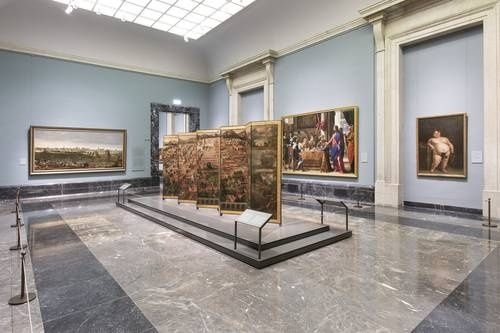The Prado Museum restores and exhibits screen of the Conquest of Mexico
On one side, this two-beam screen represents the conquest of Tenochtitlan, and on the other, Mexico City, and was probably a gift to a viceroy.

It is one of the jewels of Viceroyal art, a screen dating from the 17th century that narrates the Conquest of Mexico, on the one hand, and the emergence of the New World, on the other. It is one of the three most important screens known from that period and has been in Spain for at least 150 years, in a private collection and never before exhibited to the public.
The Prado Museum, in a long-term project that aims to vindicate the importance of viceregal art in history, now exhibits it after long and meticulous restoration work, in which they cleaned the oxidized varnishes, polished the gold finishes, and even reconstructed the locks of the 10 wooden doors that make up the piece, each of them painted on both sides.
The screen as an artistic object was imported from the Asian tradition, especially from Japan and China, which arrived in Mexico between the sixteenth and seventeenth centuries through expeditions from the Philippines. There were specialized workshops, most of them with artists who remained anonymous and who almost always made choral works, in which historical episodes, epic battles, or simple recreations of nature or mythology were recounted.
These pieces served as decorative objects in the homes of the great potentates, but also as a motif of debate and discussion in the meetings that took place in those houses.
The screen now on display at the Museo del Prado after a long restoration of more than eight months, known as the Screen of the Conquest of Mexico and the Most Noble and Loyal Mexico City, is one of the great jewels of viceregal art. It is among the three most important known, along with those of the Franz Mayer and Soumaya museums.
It arrived in Spain 150 years ago
This work belongs to a private collection and arrived in Spain about 150 years ago, and since then it had remained hidden or stored, sometimes in unfavorable conditions for its conservation. In fact, its condition when it arrived at the restoration workshop of the Prado Museum was very bad, with humidity, very deteriorated fabrics, and stains all over the piece, the result of poorly executed restoration attempts that caused alterations to the original.
Despite its historical and artistic importance in viceregal art, the screen has not seen the light of day until now, thanks mainly to the commission of viceregal art created by the Friends of the Prado Museum Foundation to make visible and give the historical importance it deserves to the art that was created on the other side of the Atlantic, among other things, to overcome the atavism that still prevails in Spain about art and the origins of its great national collections.
This two-beam screen represents, on one side, the conquest of Tenochtitlan, and on the other, Mexico City, and was probably a gift from the city council to a viceroy upon assuming the capital's government, head of the kingdom.
As such, it evokes notions central to the culture and memory of the Creole elites of the capital of New Spain. The screen demonstrates the peculiarity of Mexico City as the capital of New Spain and the scene of its history and visualizes the way in which its inhabitants showed their relationship with the Hispanic monarchy, to which they owed political loyalty and the origin of their faith, but also the pride and uniqueness of an American and Creole reality that would crystallize more than a century later in the process of independence.
El haz de la Conquista presents multiple scenes, occurring in different places and moments, even years, with the vision of the conquistadors and their Creole descendants, beginning with the reception of Hernán Cortés by Moctezuma and concluding with the taking of Tlatelolco, the last indigenous bastion. Meanwhile, the beam of La muy noble y leal Ciudad de México, in contrast to the Conquest, shows an orderly and harmonious world.
The city is observed from the heights and 66 prominent buildings or sites are identified, mainly linked to religious life, as well as the viceregal palace, Chapultepec Hill, the Alameda promenade, and the main roads. The image shows everyday scenes, but above all, it delves into the apparent serenity and calmness, in contrast to the convulsion of violence and destruction of its obverse side, in which blood, sword, and arrow stain the linen canvases of pain and devastation.
The screen will be on display at the Prado Museum until September 26, and will then be part, also at the Prado Museum, of a temporary exhibition of Viceroyal art called Tornaviaje. After that, the screen will return to the private collection and is not expected to leave Spain or travel to Mexico.




